By J.B. Wood | Contributing Editor
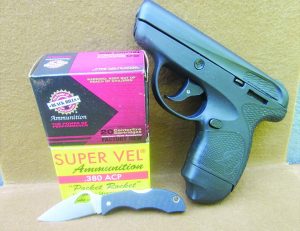
The Spectrum and the test ammo. The knife, a size-match for a small pistol, is the Byrd Starling from Spyderco.
At the start of production, all of the little .380 Taurus Spectrum pistols were in “basic black,” like the one shown here in my photos. Later, there will be a lot of colors, both in the grip-frame and the panel inserts. We’ll get to the color thing a little further on. Right now, let’s look at its other really good features.
First of all, its size and weight are perfect for deep-concealment carry. Empty, it weighs only 10 ounces. The other numbers: Over-all length is 5.4 inches. Height is, 3.8 inches with the 6-round magazine, and 4.4 inches with the 7-rounder. It is very slim, with a width of only 0.89 of an inch. A 2.8-inch barrel lets any .380 load reach a good velocity.
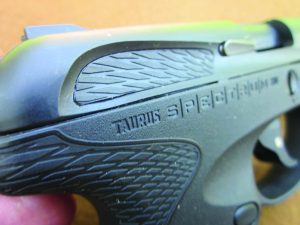
Instead of retraction grooves, the slide has deep in-curves at rear, filled with panels of a special material.
The falling-barrel locking system is a good thing in two ways. It softens the felt-recoil, and allows the use of a softer recoil spring, making slide retraction easier. On the last shot, the slide locks open. The tiny external slide latch is not intended for thumb action. Instead, you pull the slide slightly rearward, and let it go, insuring proper feed from a fresh magazine.
The Spectrum is striker-fired, but there is none of that “semi-cocked” nonsense. Unless the trigger is pulled, the striker is always forward, at rest, a tiny bit rearward of the breech face. In that position, it is securely blocked until the last fraction of trigger pull. The trigger system is a true “Double-Action-Only,” and Taurus says the pull is “7 to 9 pounds”. My trigger finger agrees.
The magazine release button is in the traditional place, at the lower rear of the trigger guard. For left-handers, it is reversible. Just above it, on both sides, there is a recess that makes a perfect thumb-rest. Also, the trigger guard has an upward indentation at its rear, allowing the second finger to ride higher.
The whole grip-frame, in fact, gives an excellent hold. There are no square, sharp edges anywhere. At upper rear, a deep incurve sets the Spectrum solidly in the hand. Of the two magazines, the 7-rounder with the small-finger rest is definitely best. And, in the shooting-comfort area, you also have the inset panels.
Those panels are quite a story. They are not “hard,” like the grip-frame, but they’re not “soft” either. The surface feel is just right. For the special material, Taurus went to PolyOne, an international firm with offices in Avon Lake, OH. Those inserts are never going to go loose. Even with 10X magnification, you can barely see the borders.
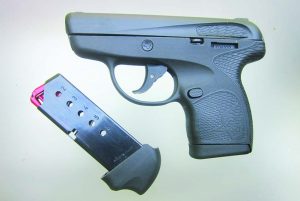
The Spectrum is shown here with the 6-round flat-base magazine inserted. The author prefers the other one.
On the grip-frame, one of the panels covers the front and sides. Another goes up the entire back. Then, there are the two in the slide, with an inward sweep that gets deeper at the rear. This arrangement, used instead of the usual slide retraction serrations, results in a superior gripping surface. My fingers like it better than the usual grooves.
The panel inserts, and the grip-frames, are going to be offered in an array of colors. Initially, there will be versions in combinations of gray, white and black. Later, there will be twenty color combinations offered. I should note that some colors will not be used, as it was found that certain ones affected the wear factor of the polymer.

Instead of retraction grooves, the slide has deep in-curves at rear, filled with panels of a special material.
Getting back to the operational details, there are three things the Spectrum does not have, and their absence is welcome. The wide, smooth-surfaced trigger does not have a stupid “flipper” safety in it. There is no magazine-disconnect safety. It is assumed that intelligent users will check the chamber when unloading. And, there’s no manual safety. With that long trigger pull, not needed!
Mentioning the trigger again reminds me to insert my usual advice on “staging” the pull, which has earned me several snarls from serious instructors. Okay, if you’re not thoroughly familiar with the pistol, don’t try this. Hey, if you don’t know it that well, you shouldn’t be handling it, anyway!
Here we go: When you pull the trigger very slowly, you can feel the hesitation point just before the striker is released to fire. This gives you a point to carefully aim before completing the pull. As I often say, it will mean you hit the terrorist, and not his hostage. Again, if you know your pistol, you can do it safely.
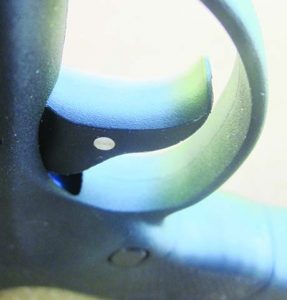
The trigger is nicely smooth-surfaced and wide.
As with most sub-compact pistols of this type, sights are not a big thing. These are square-picture, and have minimal protrusion, so they won’t snag. Both are part of the slide, thus non-adjustable. For a pistol of this type, my range-testing is standing, two-hand hold, at 7 and 15 yards. For targets, I use the Champion 100-yard “sight-in,” which has an 8-inch black.
The question is, will the Spectrum keep most shots in the middle of the black? The answer is yes. At 7 yards, most groups were 3.5 inches. At 15 yards, 4.5 to 5 inches! The ammo used was from Super Vel and Black Hills, and both were serious defense loads. No problems. The felt-recoil was noticeable, but it didn’t hurt.
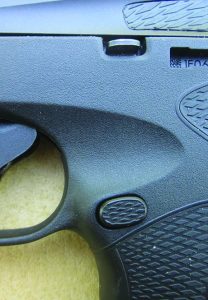
The slide latch and magazine release are in the usual locations. The takedown latch is on the right side above the trigger.
For the after-shooting clean-up, takedown is easy. On the right side of the frame, above the trigger, is what seems to be the head of a wide-slotted screw. That’s the takedown latch. With the magazine out and the chamber empty, use a cartridge rim, or some other non-marring tool, to turn it counter-clockwise so the slot goes from vertical to horizontal, and move the slide assembly off forward.
Remove the recoil spring unit and the barrel from the slide, and that’s as far as you need to go. One caution — the recoil spring and its guide are not captive units, so keep them under control during removal. With any pistol, any time you fool with the insides, you should be wearing safety glasses. (I wish somebody, 60 years ago, had told me that!)
The “basic-black” version of the Spectrum has a retail suggested price of $289, but you can probably find it for a little less. For special color combinations, probably a bit more. Either way, you get a lot for your money. The contact data: Taurus International Mfg. Inc., 16175 m 49th Ave., Miami, PL 33014; phone: 305-624-1115; online: taurususa.com.



